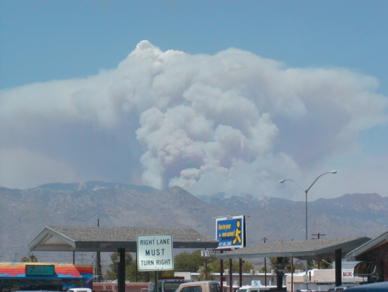Pollutant: различия между версиями
Перейти к навигации
Перейти к поиску

Marina (обсуждение | вклад) |
Marina (обсуждение | вклад) |
||
| Строка 1: | Строка 1: | ||
| − | [[Файл:Загрязнение атмосферы.png|альт=|мини|388x388пкс|A natural source of atmospheric pollution. The “Aspen Fire” burned for weeks in the Catalina Mountains near Tucson, Arizona, releasing large amounts of particulates and other air pollutants. (Photo courtesy J.F. Artiola.).<ref>Brusseau M.L., Matthias A.D., Comrie A.C., Musil S.A. Atmospheric Pollution, Chapter 17. – Environmental and Pollution Science, 2019, | + | [[Файл:Загрязнение атмосферы.png|альт=|мини|388x388пкс|A natural source of atmospheric pollution. The “Aspen Fire” burned for weeks in the Catalina Mountains near Tucson, Arizona, releasing large amounts of particulates and other air pollutants. (Photo courtesy J.F. Artiola.).<ref>Brusseau M.L., Matthias A.D., Comrie A.C., Musil S.A. Atmospheric Pollution, Chapter 17. – Environmental and Pollution Science, 2019, p. 293-309.</ref>]] |
==Загрязнитель (загрязняющее вещество)== | ==Загрязнитель (загрязняющее вещество)== | ||
| Строка 11: | Строка 11: | ||
# In Europe for instance, diffuse agricultural pollution poses significant pressure on 38% of the region’s water bodies.<ref>Okumah M., Chapman P. J., Martin-Ortega J., Novo P. / Mitigating agricultural diffuse pollution: Uncovering the evidence base of the awareness-behaviour-water quality pathway // Water (Switzerland). – 2018. – Vol. 11(1). – No 29.</ref> | # In Europe for instance, diffuse agricultural pollution poses significant pressure on 38% of the region’s water bodies.<ref>Okumah M., Chapman P. J., Martin-Ortega J., Novo P. / Mitigating agricultural diffuse pollution: Uncovering the evidence base of the awareness-behaviour-water quality pathway // Water (Switzerland). – 2018. – Vol. 11(1). – No 29.</ref> | ||
| − | 2. Pollutants include (groups of) substances that do not naturally occur in aquatic systems (e.g. plastic debris or synthetic chemicals) or with concentrations deviating from their optimal range (e.g. nutrients).<ref>Strokal M., Spanier J. E., Kroeze C., Koelmans A. A., Flörke M., Franssen W., Williams, R. Global multi-pollutant modelling of water quality: scientific challenges and future directions // Current Opinion in Environmental Sustainability. - 2019. - №36. - | + | 2. Pollutants include (groups of) substances that do not naturally occur in aquatic systems (e.g. plastic debris or synthetic chemicals) or with concentrations deviating from their optimal range (e.g. nutrients).<ref>Strokal M., Spanier J. E., Kroeze C., Koelmans A. A., Flörke M., Franssen W., Williams, R. Global multi-pollutant modelling of water quality: scientific challenges and future directions // Current Opinion in Environmental Sustainability. - 2019. - №36. - p. 116-125.</ref> |
==Перевод использования на русском языке== | ==Перевод использования на русском языке== | ||
Текущая версия на 23:15, 25 апреля 2024

A natural source of atmospheric pollution. The “Aspen Fire” burned for weeks in the Catalina Mountains near Tucson, Arizona, releasing large amounts of particulates and other air pollutants. (Photo courtesy J.F. Artiola.).[1]
Загрязнитель (загрязняющее вещество)
Любой природный или антропогенный агент, попадающий в окружающую природную среду в количествах, превышающих фоновые значения и вызывающий тем самым её загрязнение.[2]
Определение на английском
Pollutant a substance that makes land, water, air, etc., dirty and not safe or suitable to use : something that causes pollution.[3]
Пример использования термина на английском языке
- In Europe for instance, diffuse agricultural pollution poses significant pressure on 38% of the region’s water bodies.[4]
2. Pollutants include (groups of) substances that do not naturally occur in aquatic systems (e.g. plastic debris or synthetic chemicals) or with concentrations deviating from their optimal range (e.g. nutrients).[5]
Перевод использования на русском языке
- К примеру, в Европе диффузное сельскохозяйственное загрязнение оказывает значительное воздействие на 38% водных объектов региона.
2. К загрязнителям относятся группы веществ, которые не встречаются в природе в водных системах (например, пластик или синтетические химикаты) или концентрация которых выше оптимального диапазона (например, питательные вещества).
Список литературы
- ↑ Brusseau M.L., Matthias A.D., Comrie A.C., Musil S.A. Atmospheric Pollution, Chapter 17. – Environmental and Pollution Science, 2019, p. 293-309.
- ↑ Рустембекова С.А., Барабошкина Т.А. Микроэлементозы и факторы экологического риска. // Под ред. В.В.Горшкова. - М.: Университетская книга, Логос, 2006, 112 с.
- ↑ Pollutant // The Britannica Dictionary URL: https://www.britannica.com/dictionary/pollutant (date of the application: 26.04.2024).
- ↑ Okumah M., Chapman P. J., Martin-Ortega J., Novo P. / Mitigating agricultural diffuse pollution: Uncovering the evidence base of the awareness-behaviour-water quality pathway // Water (Switzerland). – 2018. – Vol. 11(1). – No 29.
- ↑ Strokal M., Spanier J. E., Kroeze C., Koelmans A. A., Flörke M., Franssen W., Williams, R. Global multi-pollutant modelling of water quality: scientific challenges and future directions // Current Opinion in Environmental Sustainability. - 2019. - №36. - p. 116-125.